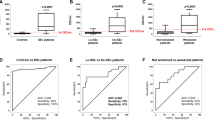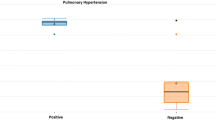Abstract
Purpose
To assess the serum profile of factors involved in endothelial, T-cell, and fibroblast interplay in patients with Raynaud’s phenomenon (RP) associated with nailfold vodeocapillaroscopy (NVC) scleroderma findings and/or systemic sclerosis (SSc) marker autoantibodies, recently labeled as early SSc patients.
Methods
Serum levels of soluble intercellular adhesion molecule-1 (sICAM-1), soluble vascular adhesion molecule-1 (sVCAM-1), CCL2, CXCL8, IL-13, IL-33, and transforming growth factor-β (TGF-β) were measured in 24 early SSc patients, 48 definite SSc patients, and 24 osteoarthritis/fibromyalgia controls by multiplex suspension immunoassay. All SSc patients were investigated for the presence/absence of preclinical and clinical organ involvement, SSc marker autoantibodies, and NVC abnormalities.
Results
Serum sICAM-1, CCL2, CXCL8, and IL-13 were increased in all SSc patients as compared to controls, and paralleled the severity of the disease subset (early SSc < limited cutaneous SSc < diffuse cutaneous SSc; p < 0.0001). Surprisingly, IL-33 was significantly higher in early SSc patients as compared to both controls (p < 0.01) and definite SSc patients (p < 0.05). In early SSc there were no differences in the investigated markers according to the functional and serological features assessed.
Conclusions
Our study suggests that an endothelial, T-cell and fibroblast activation can be present in patients with early SSc and it is associated with a distinct profile of circulating factors involved in the cross-talk of these cells. The marked increase of IL-33 in early SSc patients suggests new routes of investigation of cell-cell dynamics in target tissues predating overt disease manifestations, thus opening to new therapeutic approaches.


Similar content being viewed by others
References
Gu YS, Kong J, Cheema GS, Keen CL, Wick G, Gershwin ME. The immunobiology of systemic sclerosis. Semin Arthritis Rheum. 2008;38:132–60.
Fleischmajer R, Perlish JS. The pathophysiology of the fibrosis in scleroderma skin. Prog Clin Biol Res. 1984;154:381–404.
Greenblatt MB, Aliprantis AO. The immune pathogenesis of scleroderma: context is everything. Curr Rheumatol Rep. 2013;15:297.
De Palma R, D’Aiuto E, Vettori S, Cuoppolo PP, Abbate G, Valentini G. Peripheral T cells from early systemic sclerosis patients kill autologous fibroblasts in co-culture: is T-cell response aimed to play a protective role? Rheumatology (Oxford). 2010;49:1257–66.
Valentini G, Cuomo G, Abignano G, Petrillo A, Vettori S, Capasso A, et al. Early systemic sclerosis: assessment of clinical and pre-clinical organ ivolvement in patients with different disease features. Rheumatology (Oxford). 2011;50:317–23.
Valentini G, Marcoccia A, Cuomo G, Vettori S, Iudici M, Bondanini F, et al. Early systemic sclerosis: marker autoantibodies and videocapillaroscopy patterns are each associated with distinct clinical, functional and cellular activation markers. Arthritis Res Ther. 2013;15:R63.
Subcommittee for Scleroderma Criteria of the American Rheumatism Association Diagnostic and Therapeutic Criteria Committee: Preliminary criteria for classification of systemic sclerosis (scleroderma). Arthritis Rheum 1980; 23:581–90
Van den Hoogen F, Khanna D, Fransen J, Johnson SR, Baron M, Tyndall A, et al. 2013 classification criteria for systemic sclerosis: an American College of Rheumatology/European League against rheumatism collaborative initiative. Arthritis Rheum. 2013;65:2737–47.
LeRoy EC, Black CM, Fleichmajer R, Jablonksa S, Krieg T, Medsger Jr TA, et al. Scleroderma (systemic sclerosis). Classification, subset and pathogenesis. J Rheumatol. 1988;15:202–5.
Cappelli S, Bellando Randone S, Martinovic D, Tamas MM, Pasalic K, Allanore Y, et al. “To be or not to be,” ten years after: evidence for mixed connective tissue disease as a distinct entity. Semin Arthritis Rheum. 2012;41:589–98.
Yoshizaki A, Yanaba K, Iwata Y, Komura K, Ogawa A, Akiyama Y, et al. Cell adhesion molecole regulate fibrotic process via Th1/Th2/Th17 cell balance in a bleomycin-induced scleroderma model. J Immunol. 2010;185:2502–15.
Codullo V, Baldwin HM, Singh MD, Fraser AR, Wilson C, Gilmour A, et al. An investigation of the inflammatory cytokine and chemokine network in systemic sclerosis. Ann Rheum Dis. 2011;70:1115–21.
Fuschiotti P. Role of IL-13 in systemic sclerosis. Cytokine. 2011;56:544–9.
Rankin AL, Mumm JB, Murphy E, Turner S, Yu N, McClanahan TK, et al. IL-33 induces IL-13-dependent cutaneous fibrosis. J Immunol. 2010;184:1526–35.
Varga J, Whitfield ML. Transforming growth factor-beta in systemic sclerosis (scleroderma). Front Biosci (Schol Ed). 2009;1:226–35.
Kuryliszyn-Moskal A, Klimiuk PA, Sierakowski S. Soluble adhesion molecules (sVCAM-1, sE-selectin), vascular endothelial growth factor (VEGF) and endothelin-1 in patients with systemic sclerosis: relationship to organ systemic involvement. Clin Rheumatol. 2005;24:111–6.
Denton CP, Bickerstaff MC, Shiwen X, Carulli MT, Haskard DO, Dubois RM, et al. Serial circulating adhesion molecule levels reflect disease severity in systemic sclerosis. Br J Rheumatol. 1995;34:1048–54.
Snowden N, Coupes B, Herrick A, Illingworth K, Jayson MI, Brenchley PE. Plasma TGF-beta in systemic sclerosis: a cross sectional study. Ann Rheum Dis. 1994;53:763–7.
Dziadzio M, Smith RE, Abraham DJ, Black CM, Denton CP. Circulating levels of active transforming growth factor beta1 are reduced in diffuse cutaneous systemic sclerosis and correlate inversely with the modified Rodnan skin score. Rheumatology (Oxford). 2005;44:1518–24.
Wolf SI, Howat S, Abraham DJ, Pearson JD, Lawson C. Agonistic anti-ICAM-1 antibodies in scleroderma: activation of endothelial pro-inflammatory cascade. Vasc Pharmacol. 2013;59:19–26.
Mehrad B, Keane MP, Strieter RM. Chemokines as mediators of angiogenesis. Thromb Haemost. 2007;97:755–62.
Wynn T. Cellular and molecular mechanisms of fibrosis. J Pathol. 2008;241:199–210.
Van de Veerdonk FL, Netea MG. New insights in the immunobiology of IL-1 family members. Front Immunol. 2013;4:167.
Schmitz J, Owyang A, Oldham E, Song Y, Murphy E, McClanahan TK, et al. IL-33, an interleukin-1-like cytokine that signals via the IL-1 receptor-related protein ST2 and induces T helper type 2-associated cytokines. Immunity. 2005;23:479–90.
Chackarian AA, Oldham ER, Murphy EE, Schimtz J, Pflanz S, Kastelein RA, et al. IL-1 receptor accessory protein and ST2 comprise the IL-33 receptor complex. J Immunol. 2007;179:2551–5.
Manetti M, Guiducci S, Ceccarelli C, Romano E, Bellando-Randone S, Conforti ML, et al. Increased circulating levels of interleukin 33 in sistemic sclerosis correlate with early disease stage and microvascular involvement. Ann Rheum Dis. 2011;70:1876–8.
Terras S, Opitz E, Moritz RKC, Höxtermann S, Gambichler T, Kreuter A. Increased serum IL-33 levels may indicate vascular involvement in systemic sclerosis. Ann Rheum Dis. 2013;72:144–5.
Manetti M, Ibba-Manneschi L, Liakouli V, Guiducci S, Milia AF, Benelli G, et al. The IL1-like cytokine IL-33 and its receptor ST2 are abnormally espresse in the affected skin and visceral organs of patients with systemic sclerosis. Ann Rheum Dis. 2010;69:598–605.
Financial Support
This study was supported by a grant of the Italian Foundation for Arthritis Research (FIRA).
Conflict of Interest
All authors of this article declare they have no competing interests.
Author information
Authors and Affiliations
Corresponding author
Rights and permissions
About this article
Cite this article
Vettori, S., Cuomo, G., Iudici, M. et al. Early Systemic Sclerosis: Serum Profiling of Factors Involved in Endothelial, T-cell, and Fibroblast Interplay is Marked by Elevated Interleukin-33 Levels. J Clin Immunol 34, 663–668 (2014). https://doi.org/10.1007/s10875-014-0037-0
Received:
Accepted:
Published:
Issue Date:
DOI: https://doi.org/10.1007/s10875-014-0037-0




